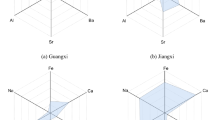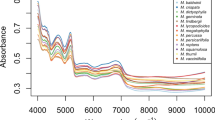Abstract
The strontium (Sr) isotope ratio (87Sr/86Sr) and Sr content were used to trace the geographical origin of onions from Japan and other countries, including China, the United States of America, New Zealand, Australia, and Thailand. The mean 87Sr/86Sr ratio and Sr content (dry weight basis) for onions from Japan were 0.70751 and 4.6 mg kg−1, respectively, and the values for onions from the other countries were 0.71199 and 12.4 mg kg−1, respectively. Linear discriminant analysis was performed to classify onions produced in Japan from those produced in the other countries based on the Sr data. The discriminant equation derived from linear discriminant analysis was evaluated by 10-fold cross validation. As a result, the origins of 92% of onions were correctly classified between Japan and the other countries.
Similar content being viewed by others
References
D. R. Henderson, C. R. Handy, and S. Neff, “Globalization of the Processed Foods Market”, ERS/USDA Agricultural Economics Report No. 742, 1996, Washington, D.C.
United Nations, “Guide to Geographical Indications: Linking Products and Their Origins”, 2010, United Nations, New York.
Statistics Department, Minister’s Secretariat, Ministry of Agriculture, Forestry and Fisheries, “Amount of Production Statistics for Agricultural Product in 2012”, http://www.maff.go.jp/j/tokei/kouhyou/sakumotu/sakkyou_yasai/index.html/.
Ministry of Finance Japan, “Trade Statistics of Japan for onion in 2012”, http://www.customs.go.jp/toukei/srch/index.htm?M=03&P=0/.
D. M. A. M. Luykx and S. M. van Ruth, Food Chem., 2008, 707, 897.
P. Cheajesadagul, C. Arnaudguilhem, J. Shiowatana, A. Siripinyanond, and J. Szpunar, Food Chem., 2013, 747, 3504.
G. Lo Feudo, A. Naccarato, G. Sindona, and A. Tagarelli, J. Agric. Food Chem., 2010, 58, 3801.
C. Herrero Latorre, J. Barciela Garcia, S. Garcia Martin, and R. M. Pena Crecente, J. Agric. Food Chem., 2013, 67, 8444.
Z. Hubalkova, P. Kralik, J. Kasalova, and E. Rencova, J. Agric. Food Chem., 2008, 56, 3454.
K. Hara, Y. Kon, S. Sasazaki, F. Mukai, and H. Mannen, Anim. Sci. J., 2010, 87, 506.
C. Montealegre, M. L. Marina Alegre, and C. Garcia-Ruiz, J. Agric. Food Chem., 2010, 58, 28.
F. Angerosa, O. Bréas, S. Contento, C. Guillou, F. Reniero, and E. Sada, J. Agric. Food Chem., 1999, 47, 1013.
M. T. Osorio, A. P. Moloney, O. Schmidt, and F. J. Monahan, J. Agric. Food Chem., 2011, 59, 3285.
H. Hiraoka, S. Morita, Y. Gotou, S. Hattori, T. Ishikawa, and K. Okano, Fish. Sci., 2014, 80, 635.
E. Wada, Y. Kamaya, and Y. Kurihara, J. Biosci., 1993, 78, 483.
J. M. Hayes, Mineral Geochem., 2001, 43, 225.
K. Ariyama, Y. Aoyama, A. Mochizuki, Y. Homura, M. Kadokura, and A. Yasui, J. Agric. Food Chem., 2007, 55, 347.
K. Ariyama, M. Kadokura, and T. Suzuki, J. AOAC Int., 2008, 97, 445.
E. Furia, A. Naccarato, G. Sindona, G. Stabile, and A. Tagarelli, J. Agric. Food Chem., 2011, 59, 8450.
J. L. Banner, Earth-Sci. Rev., 2004, 65, 141.
R. C. Capo, B. W. Stewart, and O. A. Chadwick, Geoderma, 1998, 82, 190.
A. Kawasaki, H. Oda, and T. Hirata, Soil Sci. Plant Nutl., 2002, 48, 635.
Y.-H. Yang, F.-Y. Wu, L.-W. Xie, J.-H. Yang, and Y.-B. Zhang, Spectrochim. Acta, Part B, 2011, 66, 656.
Y.-S. Bong, W.-J. Shin, M. K. Gautam, Y.-J. Jeong, A.-R. Lee, C.-S. Jang, Y.-P. Lim, G.-S. Chung, and K.-S. Lee, Food Chem., 2012, 735, 2666.
K. Ariyama, M. Shinozaki, and A. Kawasaki, J. Agric. Food Chem., 2012, 60, 1628.
G. Durante, C. Baschieri, L. Bertacchini, M. Cocchi, S. Sighinolfi, M. Silvestri, and A. Marchetti, Food Chem., 2013, 747, 2779.
R. H. Steiger and E. Jäger, Earth Planet. Sci. Lett., 1977, 36, 359.
Y. Kanda, Bone Marrow Transplant., 2013, 48, 452.
Y. Yokoo and T. Nakano, Water Air Soil Pollut., 2001, 730, 1583.
H. Kurasawa and H. Fujimaki, Kazan 2 [in Japanese with English abstract], 1977, 22, 249.
H. Kurasawa, Chigaku Zasshi [in Japanese with English abstract], 1986, 95, 30.
Y. Asahara, H. Ishiguro, T. Tanaka, K. Yamamoto, K. Mimura, M. Minami, and H. Yoshida, Appl. Geochem., 2006, 27, 419.
S. Kusaka, T. Nakano, T. Yumoto, and M. Nakatsukasa, J. Archaeol. Sci., 2011, 38, 166.
Y. Jomori, M. Minami, A. Ohta, M. Takeuchi, and N. Imai, Geochem. J., 2013, 47, 321.
Y. Wang, Q. Guo, C. Su, and T. Ma, J. Hydrol., 2006, 328, 592.
J. B. West, J. M. Hurley, F. O. Dudás, and J. R. Ehleringer, J. Forensic Sci., 2009, 54, 1261.
C. A. Fleming, in “Biogeography and Ecology in New Zealand”, ed. G. Kuschel, 1985, Springer Netherlands, 1.
J. W. Cole, New Zeal. J. Geol. Geop., 1979, 22, 631.
R. Millot, A. Hegan, and P. Négrel, Appl. Geochem., 2012, 27, 677.
D. B. Seymour, G. R. Green, and C. R. Calver, “Geological Survey Bulletin 72”, 2006, Department of Infrastructure, Energy and Resources, Australia.
H.-C. Liu, C.-F. You, K.-F. Huang, and C.-H. Chung, Talanta, 2012, 88, 338.
Acknowledgments
The authors thank Prof. S. Aoki at the Faculty of Social and Information Studies, Gunma University, for advice on statistical analyses.
Author information
Authors and Affiliations
Corresponding author
Rights and permissions
About this article
Cite this article
Hiraoka, H., Morita, S., Izawa, A. et al. Tracing the Geographical Origin of Onions by Strontium Isotope Ratio and Strontium Content. ANAL. SCI. 32, 781–788 (2016). https://doi.org/10.2116/analsci.32.781
Received:
Accepted:
Published:
Issue Date:
DOI: https://doi.org/10.2116/analsci.32.781




